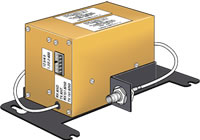This product is not available for new orders.

| Services Available | |
|---|---|
| Repair | No |
| Calibration | No |
| Free Support | No |
Overview
NOTE: The RF300-series transceivers are still available for customers who already own RF300-series transceivers, but for newer radio customers, the RF320-series is usually a better choice.
The RF302 is a DRL UHF radio transceiver for customers who will have an FCC-assigned frequency in the range of 450 to 470 MHz. It's programmed to an exact user-specified frequency by Campbell Scientific using special software.
Read More
The RF300-series are radio transceivers used in Campbell Scientific radiotelemetry networks. The following table shows the frequency ranges assigned to each model.
| Model | Type | Frequency |
| RF300 | VHF | 150 to 174 MHz |
| RF301 | VHF | 132 to 150 MHz |
| RF302 | UHF | 450 to 470 MHz |
| RF303 | UHF | 403 to 419 MHz |
| RF304 | UHF |
419 to 435 MHz |
These transceivers meet NTIA narrowband and FCC re-farming requirements for transmission.
Images

Similar Products
Detailed Description
NOTE: The RF300-series transceivers are still available for customers who already own RF300-series transceivers, but for newer radio customers, the RF310-series is usually a better choice.
The RF302 is a Dataradio 3412-510 UHF radio transceiver for customers who have an FCC-assigned frequency in the range of 450 to 470 MHz. The transceiver is programmed to an exact user-specified frequency by Campbell Scientific using special software.
Besides the radio, each field station and repeater station must also have an RF500M Radio Modem or RF95(A) Radio Modem; base stations need an RF500M radio modem, RF500B base station, or RF232(A) base station.
Specifications
| Power Output | 5 W at 13.3 V (nominal) |
| Frequency Control | Synthesized |
| Channel Spacing | 12.5/25 kHz |
| Operation Voltage |
|
| Current Drain |
|
| Operating Temperature | -30° to +60°C |
| Humidity | 95% maximum RH at 40°C (non-condensing) |
| Dimensions | 11.7 x 8.4 x 5.6 cm (4.6 x 3.3 x 2.2 in.) |
Compatibility
Note: The following shows notable compatibility information. It is not a comprehensive list of all compatible or incompatible products.
Data Loggers
| Product | Compatible | Note |
|---|---|---|
| 21X (retired) | ||
| CR10 (retired) | ||
| CR1000 (retired) | ||
| CR10X (retired) | ||
| CR200X (retired) | ||
| CR206X (retired) | ||
| CR211X (retired) | ||
| CR216X (retired) | ||
| CR23X (retired) | ||
| CR295X (retired) | ||
| CR3000 (retired) | ||
| CR500 (retired) | ||
| CR5000 (retired) | ||
| CR510 (retired) | ||
| CR800 (retired) | ||
| CR850 (retired) | ||
| CR9000 (retired) | ||
| CR9000X (retired) |
Additional Compatibility Information
Radios, Radio Modems, and Radio Base Stations
The RF302 is compatible with the RF500M radio modems, RF500B base stations, RF95(A) radio modems, RF232(A) base stations, E.F. Johnson-series radios, and P50-series radios. The RF302 is NOT compatible with the RF310M radio modem, RF310B Base Station, and RF310-series radios.
Documents
Frequently Asked Questions
Number of FAQs related to RF302: 1
-
It is possible to connect two antennas to a single radio via a properly specified (operating frequency and power handling capability) two-way, 50 ohm RF power divider. One example of this type of power divider is offered by Pasternack. Note that using a device like this will induce additional losses into the system (3 to 4 dB, typically).
Privacy Policy Update
We've updated our privacy policy. Learn More
Cookie Consent
Update your cookie preferences. Update Cookie Preferences
